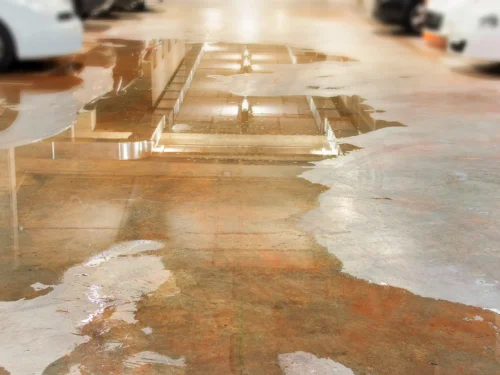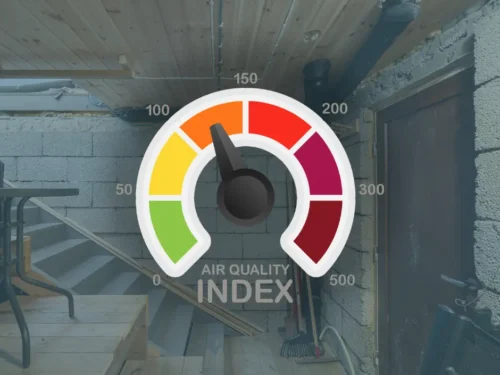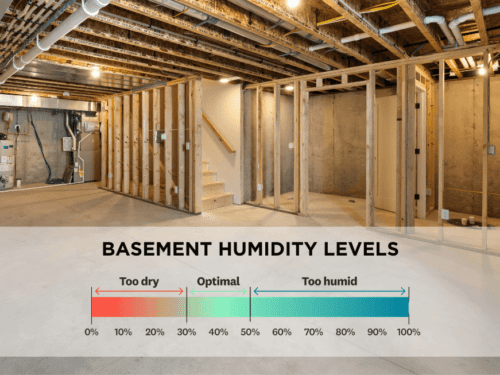Basements, often overlooked as valuable living spaces, can quickly become a homeowner’s nightmare when confronted with the relentless force of hydrostatic pressure.
This hidden enemy, resulting from groundwater buildup against foundation walls, can cause severe water damage, impact structural integrity, and compromise your living environment.
If you’re dealing with this challenge and are curious about how to fix hydrostatic pressure in the basement floor, let’s explore the best ways to prevent it from wreaking havoc on your foundation.
What is Hydrostatic Pressure, and What Causes It?
Hydrostatic pressure refers to the force exerted by standing water against the basement walls. This pressure typically arises when excessive rainwater or melted snow saturates the soil surrounding the foundation. As the ground becomes waterlogged, it exerts increasing pressure on the basement walls and floor, potentially leading to water infiltration through cracks or gaps.
Several factors contribute to hydrostatic pressure:
- High water table: A high water level in the surrounding soil increases the potential for hydrostatic pressure.
- Soil composition: Clay-rich soil retains more water, intensifying the pressure on the basement.
- Poor drainage: Poor drainage systems allow water to accumulate around the foundation.
Hydrostatic pressure water in basement floors can also result from seasonal changes. During spring or fall, heavy rains combined with poor yard drainage can increase the likelihood of water seeping into your basement. Identifying these seasonal triggers can help you address the root cause more effectively.
Signs of Hydrostatic Pressure in Basement Floors
Recognizing the early signs of hydrostatic pressure basement floor problems can save you thousands in repairs.
Look for:
- Cracks in basement floors or walls
- Bowing or bulging walls
- Efflorescence (white, chalky residue on concrete)
- Standing water or puddles on the floor
- Musty odors and visible mold
Ignoring these hydrostatic pressure basement floor signs allows pressure to build, leading to more serious structural issues.
How to Diagnose Hydrostatic Pressure vs. Other Basement Water Problems
When your basement shows signs of moisture, the cause isn’t always obvious — and misdiagnosing it can cost you thousands. So how do you know if you’re actually dealing with hydrostatic pressure in the basement floor — and not just a plumbing leak or surface water?
Here’s how to tell:
Signs of Hydrostatic Pressure:
- Water seeping up through the basement floor, not just from the walls.
- Cracks in the slab with wet edges or standing water.
- Water appears after heavy rain or snowmelt — especially if your yard doesn’t drain well.
- Efflorescence (white, chalky residue) on floor or lower wall areas.
These signs usually mean hydrostatic water pressure is pushing moisture through your foundation. That pressure builds when the ground around your home is saturated and there’s nowhere for the water to go — so it finds its way into your basement.
If water rises from below the floor slab instead of dripping from the ceiling or wall, you’re likely dealing with hydrostatic pressure in the basement floor, not a pipe or window leak.
Signs It’s Not Hydrostatic Pressure:
- Localized puddles under a pipe = plumbing leak.
- Water stains only at the top of the wall = surface runoff or grading issue.
- Condensation on walls = poor ventilation or humidity, not pressure.
What to Do Next and How To Fix Hydrostatic Pressure In Basement Floor:
To confirm, place a plastic sheet (about 2′ x 2′) on the floor and tape the edges down for 48 hours:
- If condensation forms under the plastic = moisture’s coming up = hydrostatic water pressure.
- If it forms on top = high humidity.
If you confirm it’s hydrostatic pressure in your basement floor, you need a drainage or waterproofing fix — not just a patch or sealant.
How Hydrostatic Water Pressure Damages Your Foundation
Unchecked, hydrostatic water pressure does more than just cause puddles. It can:
- Widen and deepen existing foundation cracks
- Cause sections of the concrete slab to shift or lift
- Weaken the overall structural integrity of the home
- Promote mold and mildew growth, impacting air quality
Over time, this pressure not only threatens your basement but the safety of your entire home.
How Long Does Hydrostatic Pressure Last?
Hydrostatic pressure is not a one-time issue. It varies based on weather conditions, soil composition, and the effectiveness of your drainage system.
Typically, hydrostatic pressure in the basement lasts as long as the soil around your foundation remains saturated. After heavy rain or snowmelt, this pressure can persist until the soil dries out, which can take days to weeks.
In areas with persistent rainfall or high water tables, the pressure can be a continual problem, making effective management crucial.
For homes with recurring hydrostatic pressure water in basement floors, the addition of a permanent drainage solution, such as a sump pump or exterior waterproofing, can significantly reduce the risks. These methods ensure that water does not pool around the foundation, minimizing long-term issues.
Can Hydrostatic Pressure Go Away on Its Own?
In short: no, at least not reliably.
While temporary drying may reduce the pressure, it will return with the next storm or seasonal thaw. Relying on “waiting it out” can lead to worsening damage, so it’s better to know how to stop hydrostatic pressure in the basement floor. Permanent solutions like drainage systems and waterproofing are necessary to truly stop the problem.
Ways to Prevent Hydrostatic Pressure
While it’s best to address hydrostatic pressure during the home construction phase, most of us aren’t building new homes. Here are some hydrostatic pressure basement fixes you can take now to prevent it from causing havoc.
1. Improve Drainage
Excess water and poor drainage spell trouble. Here’s how to prevent water from pooling around your home:
- Redirect gutters and downspouts: Ensure they drain away from your foundation. Rainwater pooling near your house can seep into the foundation.
- Proper yard grading: Make sure the ground slopes away from your house in all directions. This helps water flow naturally away, reducing the risk of pooling and pressure.
Proper drainage is the first line of defense against hydrostatic pressure. By keeping water away from your foundation, you reduce the amount of water that can seep into the soil and build up pressure.
Adding exterior perimeter drains around your home is another effective way to manage hydrostatic pressure in the basement floor. This system captures water before it reaches your basement walls and redirects it away, ensuring the soil surrounding your foundation remains dry.
2. Install an Interior Drainage System
A strong drainage system is essential for keeping your basement dry and preventing damage. It works by collecting and removing water effectively. For best results, install the system below the slab and ensure the drains slope downward and away from your home.
Interior drainage systems typically include French drains, which are perforated pipes installed around the perimeter of your basement floor. These pipes collect water and direct it to a sump pump, which pumps the water out and away from your home.
For homes experiencing severe hydrostatic pressure in basement floors, combining interior drainage systems with vapor barriers can provide additional protection. Vapor barriers prevent moisture from seeping through the walls and floors, reducing dampness and preventing mold growth.
3. Seal Cracks
Examine your basement walls and floor for cracks, as these can allow water to infiltrate. Address these issues promptly to avoid further damage. If you discover any cracks, reach out to a local foundation specialist for assistance. Foundation and basement flooding repair might be required to prevent additional problems.
To stop water from seeping in, seal the cracks with hydraulic cement or epoxy injections, creating a watertight barrier. This will help protect your basement from potential water damage.
Sealing cracks alone may not completely resolve hydrostatic pressure issues. Always pair this step with a robust drainage solution to ensure long-term results.
4. Invest in Professional Waterproofing
Basement waterproofing is an essential hydrostatic pressure basement fix. Interior drainage combined with sump pump installation is highly effective. The drainage system catches water before it can cause damage and directs it to the sump pump. The sump pump then moves the water away from the foundation.
This method protects against water damage and flooding, ensuring a dry and secure living area. Professional waterproofing services can also include the application of waterproof coatings to your basement walls and floor, providing an additional layer of protection against water infiltration.
Consider exterior waterproofing techniques for homes with persistent hydrostatic pressure. This involves excavating around the foundation and applying a waterproof membrane to the exterior walls, effectively blocking water from entering your basement.
5. Use a Dehumidifier
High humidity levels can contribute to moisture problems in your basement. Using a dehumidifier helps maintain a dry environment by removing excess moisture from the air. This can prevent mold growth and reduce the overall dampness in your basement.
6. Maintain Your Gutters and Downspouts
Regular maintenance of your gutters and downspouts is crucial. Ensure they are debris-free and properly direct water away from your home. Clogged or damaged gutters can cause water to overflow and pool around your foundation, increasing the risk of hydrostatic pressure in the basement.
Summary
Are you noticing signs of water damage in your basement?
Worried about how hydrostatic pressure might affect your home’s foundation?
If you have researched how to fix hydrostatic pressure in the basement floor at some point, or if you are reading this now, take action to save yourself from costly repairs in the future.
Our team at VFS is ready to provide expert solutions tailored to your specific needs. Our thorough inspection and professional services ensure your basement stays dry and secure.
Take control of hydrostatic pressure issues today. Whether you’re battling hydrostatic pressure water in basement floors or need expert advice about how to fix hydrostatic pressure in basement floors, let us help safeguard your home’s foundation.
Contact us now for a free inspection and personalized solutions to keep your basement dry and your foundation strong.








